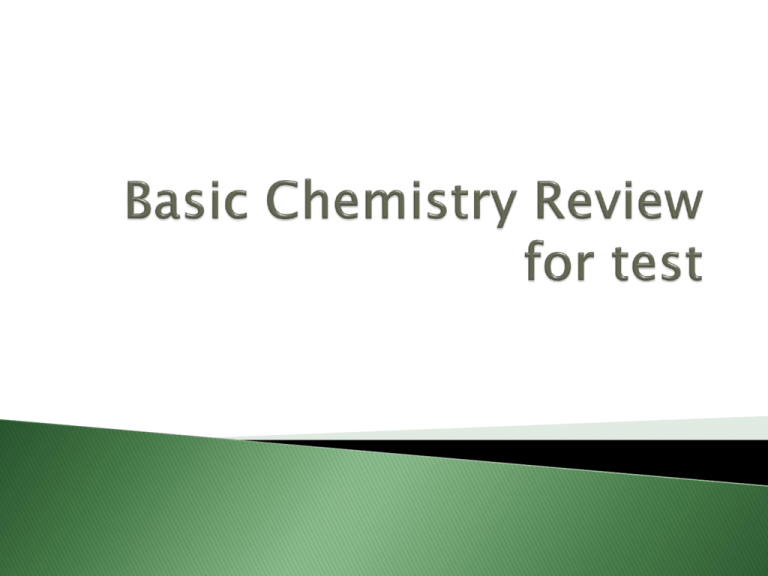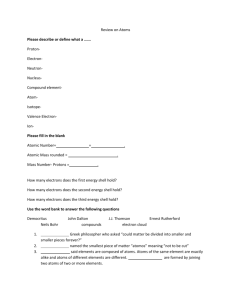Basic Chemistry Review for test
advertisement

The basic unit of all matter Small in size Proton Neutron Electron Proton and Neutron – NUCLEUS of the atom (center) Electrons – found rapidly moving in energy levels (energy clouds) Proton = Positive (+) Neutron = Neutral (0) Electron = Negative (e-) Proton Neutron Remember – the electrons are SOOOO LIGHT that they are not part of the mass (atomic weight) There is an equal number of protons and electrons If there are more protons – then the atom would have an overall POSITIVE charge If there are more electrons – then the atom would have an overall NEGATIVE charge Use the terms ◦ Symbol ◦ Atomic Weight (Mass) ◦ Atomic Number A Atomic Number Symbol Atomic Weight (mass) Hydrogen Oxygen Nitrogen Carbon There is also phosphorus and sulfur, but I only want you to focus on the four listed above. The symbol for Krypton is The mass number for Calcium is The atomic number for Beryllium is The symbol for Krypton is Kr The mass number for Calcium is The atomic number for Beryllium is 4 The number of molecules present LARGE NUMBER written before the element symbol Ex: 4CO2 There are 4 molecules of carbon dioxide The number of atoms present SMALL NUMBER written within the chemical formula Ex: 4CO2 There are 8 atoms of oxygen Remember to distribute (4 x 2=8) 5C2H4 How many molecules are present? How many atoms of Carbon are present? How many atoms of Hydrogen are present? How many TOTAL atoms are present? 5C2H4 How many molecules are present? 5 How many atoms of Carbon are present? 10 (5x2 – remember to distribute) How many atoms of Hydrogen are present? 20 (5x4 – remember to distribute) How many TOTAL atoms are present? 30 (distribute and then add up) (5x2) = 10 (5x4) = 20 10 + 20 = 30 A. Electrons B. Protons C. Neutrons D. Valence Electrons A. Electrons B. Protons C. Neutrons D. Valence Electrons Choice D is the most accurate answer here A. B. C. Gained Lost Shared A. B. C. Gained Lost Shared In the outermost energy level of an atom 8 electrons! 8 – OCTET rule ◦ The outermost energy level will be complete when it contains 8 electrons. ◦ Atoms will gain/lose/share electrons to reach this stability! ****EXCEPTION**** ◦ Hydrogen and Helium follow the DUET RULE (can only have 2 electrons in the outermost shell to be stable and unreactive) A. B. C. D. Carbon Neon Helium Magnesium A. B. C. D. Carbon – 4 opportunities to bond (vacancies) Neon Helium Magnesium – 6 opportunities to bond (vancancies) Neon is stable because it is a noble gas – already has 8 electrons Helium is stable because it is also a noble gas – but follows duet rule so it has 2 electrons Single Bond Double Bond Triple Bond Single Bond ◦ Atoms share 2 electrons (1 pair) Double Bond ◦ Atoms share 4 electrons (2 pairs) Triple Bond ◦ Atoms share 6 electrons (3 pairs) Types of Elements Number of atoms Location of atoms Example – 1 Oxygen 2 Hydrogen COVALENT BONDS SHARING OF ATOMS!! Phosphorus Hydrogen Nitrogen Oxygen Phosphorus Hydrogen Nitrogen Oxygen WATER Changes or transforms one set of chemicals into another CHANGES to the BONDS – breaking and reforming bonds Reactants Products Reactants ◦ ENTER into a chemical reaction (before the arrow) Products ◦ PRODUCED by a chemical reaction (after the arrow) Reactants Products Coefficients Subscripts C - Reactants D - Products A - Coefficients B – Subscripts Reactants REACTto produce PRODUCTS Matter cannot be created nor destroyed Arrangement of atoms is what is changed Reactants must equal products Na + Cl2 NaCl ANSWER - NO 2Na + Cl2 2NaCl





